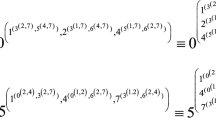Abstract
Model-driven methods have been quite effective for reducing the intricacies of embedded software development, since they provide effective means for property verification as well as automatic code generation. Nevertheless, regarding energy-constrained hard real-time systems, few model-driven methods are available and, usually, most methods (model-driven or not) consider simplified system specifications, such as absence of intertask relations. This paper presents a model-driven method for software synthesis of hard real-time embedded applications with energy constraints. A formal model based on time Petri nets is adopted in order to provide a basis for pre-runtime schedule generation and property analysis/verification.
Similar content being viewed by others
References
Xu J, Parnas D (2000) Priority scheduling versus pre-run-time scheduling. In: Real-time systems, vol 18. Kluwer Academic, Norwell, pp 7–23
Murata T (1989) Petri nets: properties, analysis and applications. Proc IEEE 77(4):541–580
Tavares E et al. (2008) Modeling hard real-time systems considering inter-task relations, dynamic voltage scaling and overheads. Microprocess Microsyst 32(8):460–473
Tavares E et al. (2008) Hard real-time tasks’ scheduling considering voltage scaling, precedence and exclusion relations. Inf Process Lett 108(2):50–59
Andrei A et al. (2005) Overhead-conscious voltage selection for dynamic and leakage energy reduction of time-constrained systems. IEE Proc, Comput Digit Tech 152:28–35
Aydin H, Melhem R, Mosse D, Mejia-Alvarez P (2004) Power-aware scheduling for periodic real-time tasks. IEEE Trans Comput 53(5):584–600
Ishihara T, Yasuura H (1998) Voltage scheduling problem for dynamically variable voltage processors. In: ISLPED’98, pp 197–202
Kim W et al. (2004) Preemption-aware dynamic voltage scaling in hard real-time systems. In: ISLPED’04, pp 393–398
Mochocki B et al. (2007) Transition-overhead-aware voltage scheduling for fixed-priority real-time systems. ACM Transact Des Automat Electron Syst 12:1084–4309
Quan G, Hu X (2007) Energy efficient dvs schedule for fixed-priority real-time systems. ACM Trans Embed Comput Syst 6
Yao F, Demers A, Shenker S (1995) A scheduling model for reduced cpu energy. In: 36th annual symposium on foundations of computer science, p 374
Jejurikar R, Gupta R (2006) Energy-aware task scheduling with task synchronization for embedded real-time systems. IEEE Trans Comput-Aided Des Integr Circuits Syst 25:1024–1037
Cai Y et al. (2007) Workload-ahead-driven online energy minimization techniques for battery-powered embedded systems with time-constraints. ACM Transact Des Automat Electron Syst 12(1):5
Cortés L, Eles P, Peng Z (2005) Quasi-static assignment of voltages and optional cycles for maximizing rewards in real-time systems with energy constraints. In: DAC’05, pp 889–894
Amnell T et al. (2003) Code synthesis for timed automata. Nord J Comput 9(4) 269–300
Kwon W, Kim T (2005) Optimal voltage allocation techniques for dynamically variable voltage processors. ACM Trans Embed Comput Syst 4(1):211–230
Nácul A, Givargis T (2006) Synthesis of time-constrained multitasking embedded software. ACM Transact Des Automat Electron Syst 11(4):822–847
Merlin P, Faber DJ (1976) Recoverability of communication protocols: Implicatons of a theoretical study. IEEE Trans Commun 24(9):1036–1043
Liebelt M et al. (2001) An energy efficient rate selection algorithm for voltage quantized dynamic voltage scaling. In: ISSS ’01, pp 124–129
Phatrapornnant T, Pont M (2006) Reducing jitter in embedded systems employing a time-triggered software architecture and dynamic voltage scaling. IEEE Trans Comput 55(2):113–124
Philips Semiconductors. Lpc2104/2105/2106; single-chip 32-bit microcontrollers: data sheet. Technical report
Amalghma and dentes tools. (2008) http://www.cin.ufpe.br/~eagt/tools
Valmari A (1998) The state explosion problem. In: Lecture notes in computer science: Lectures on Petri nets I: Basic models, vol 1491, pp 429–528
van Hee K et al. (2004) Architecture of information systems using the theory of petri nets. Lect Not Systeemmodel 1:2M310
Albuquerque G, Jr (2007) Avaliação de Desempenho de Cadeias de Suprimentos Utilizando Componentes GSPN (in portuguese). MSc thesis, Centro de Informática, Universidade Federal de Pernambuco, August 2007
Perkusich A et al. (1991) Putting Petri nets to work for controlling flexible manufacturing systems. In: IECON’91, pp 1631–1636
Jiao L et al. (2005) Property-preserving composition by place merging. J Circuits Syst Comput 14:793–812
Godefroid P (1996) Partial order methods for the verification of concurrent systems: an approach to the state-explosion problem. In: Lecture notes in computer science, vol 1032. Springer, Berlin
Leveson N, Stolzy J (1987) Safety analysis using Petri nets. IEEE Trans Softw Eng 13:386–397
Agilent Technologies. Scope connect software. Technical report
Xu J (2003) On inspection and verification of software with timing requirements. IEEE Trans Softw Eng 29(8):705–720
Kim N et al. (1996) Visual assessment of a real-time systems design: a case study on a CNC controller. In: RTSS’96, pp 300–310
Oliveira M, Jr (1998) Desenvolvimento de Um Protótipo para a Medida Não Invasiva da Saturação Arterial de Oxigênio em Humanos—Oxímetro de Pulso (in portuguese). MSc thesis, Departamento de Biofísica e Radiobiologia, Universidade Federal de Pernambuco, August 1998
Prathipati R (2004) Energy efficient scheduling techniques for real-time embedded systems. MSc thesis, Texas A&M University, USA
Triola M (2004) Elementary statistics, 9 edn. Addison-Wesley, Reading
Author information
Authors and Affiliations
Corresponding author
Rights and permissions
About this article
Cite this article
Tavares, E., Maciel, P., Dallegrave, P. et al. Model-driven software synthesis for hard real-time applications with energy constraints. Des Autom Embed Syst 14, 327–366 (2010). https://doi.org/10.1007/s10617-011-9069-3
Received:
Accepted:
Published:
Issue Date:
DOI: https://doi.org/10.1007/s10617-011-9069-3




